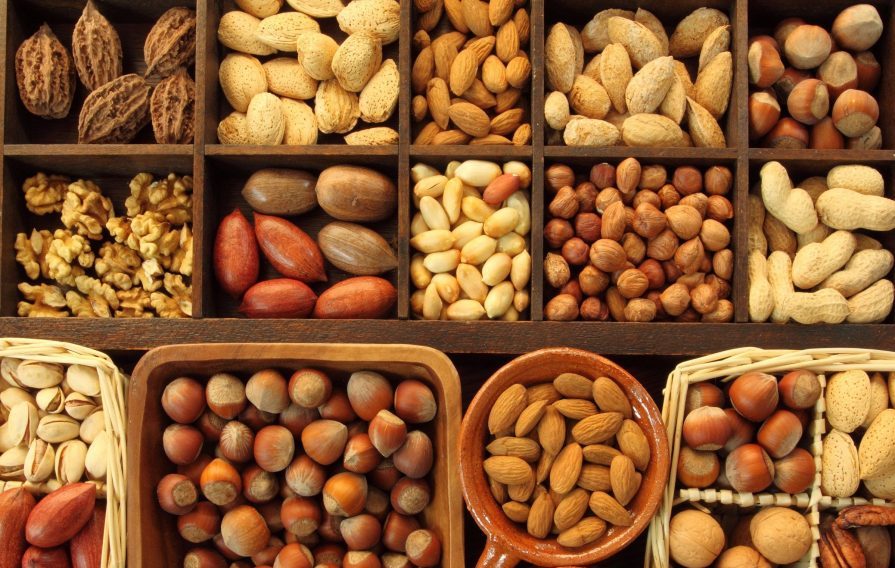
• ALMONDS •
The Californian almond board reported another record for the November shipments. A surplus of 30,9% has been quoted in comparison to the same period last year, resulting in a total year to date shipment figure of plus 7,7%. The market reacted directly after the publication of these figures with a price increase of roughly 5/10 cents per lb. With regards to the new crop, rumours are spread about a lack of rain in California. The actual impact remains to be seen, keeping the existence of water reservoirs in mind. Based on the comfortable position in which Californian shippers have found themselves this season so far, is a price decrease not expected in the nearby period.
• WALNUTS •
Eastern Europe: The market continued at a firm level during the start of 2018, as a new factor came into play. The Turkish government decreased the import taxes for walnuts significantly, from 43,2% into 15%. This is expected to put more pressure on the available product, mainly shipped by Turkish traders / handlers based in Ukraine. As a result, prices for European import (mainly from Romania and Moldova) are slightly increased as well. It remains to be seen whether this price increase will be justified by the increased demand from Turkey. So far, the price increase on quarters seems to be in line with the low availability of material. Prices for halves are still disputable, as we’ve seen several factors whom indicate large availability and pressure at sellers to move some product. Covering nearby needs is advised, as a price decrease isn’t expected on the short term.
USA: Prices from the USA seem to be on the return. December shipments were in line with last season, being roughly 1% above December 16. Despite these positive figures, are the year to date shipments still far behind last year (inshell exports -30.7% / shelled exports -8.2%). Californian suppliers are eager to move some stocks, providing some relief to the market. This downwards trend might be slowed down by the increased import levels in Turkey, as described above. So far Turkey has been one of the most important absent buyers, this might change due to the more favourable import rates. The January shipment report will provide more insight in the actual impact on the demand from Turkey. Looking back on the Turkish imports of last season, which were YTD at 111 million inshell pounds in comparison to 57 million inshell pounds this year, the impact might be more than just a drip on a hot plate..
• MACADAMIAS •
During the past weeks there has not been a lot to report. Most factories closed already early because of lack of product to process. The short position for current crop as such has not changed. There is hardly any product available and this situation is not going to change till new crop. The only relief will come from early shipments from Malawi and Kenya, but for these early positions there is only limited product available as the bulk also comes in later together with South Africa and Australia. Prices for these early positions are very high. The NIS market is a bit quiet at the moment, but that is in line with expectations. All product was shipped early in the season and was there for the main sales moments in the Chinese market. 11-11 was a bit disappointing, but the mentioning of stock levels after 11-11 is not uncommon as there is no supply in between. It will be interesting to see how the Chinese New Year sales go to give a better idea on the situation in this market.
For new crop there has already been a some buying of NIS. Most buyers however are a bit reluctant as prices remain very high. On the other hand there have been some interesting developments in terms of the import tax according plan for Australia, but also South Africa is seeing lower import taxes. Another difference is the exchange rate of the Chinese Renminbi. Last year we were looking at levels over 7, where we are today back to 6.50 levels to the Dollar.
On new crop kernel there has been some buying going on, but mainly for the first half of 2018 with early shipments from Kenya and Malawi. For later positions both buyers and sellers are reluctant to commit. Sellers don’t want to run in the same problems as last season when they were caught be adverse weather conditions that pushed basically all origins back. Australia had Cyclone Debbie and most African countries had drought situations. Last year this resulted for difficulties to execute contracts and that is something everybody wants to prevent from happening. Buyers are uncertain whether they should book at today’s levels as they are high and it is also still very early. So basically nobody is really in a hurry, but one should remember that good quality product is only in limited supply.
• CASHEWS •
The last few weeks prices for cashews slowly, but steadily went down due to lack of demand. During the past week however we have seen some increased activity for nearby positions. This resulted in some slight price increases on the spot. Stock positions are fairly limited and as such supply and demand tightly balanced. This situation is expected to hold for the coming few months as supply will be tight due to factories being closed in Vietnam as well. As soon as some demand comes in the market sellers will increase their prices as they are currently selling under their cost. There is not a real surge of demand expected, but everything will be taken as an excuse to increase. We also see that February/March shipments are at a premium. For later positions we see more attractive prices showing that there is still a feeling that prices should go lower knowing that current levels are still historically high.
Sourse:http://www.globaltrading.nl/

